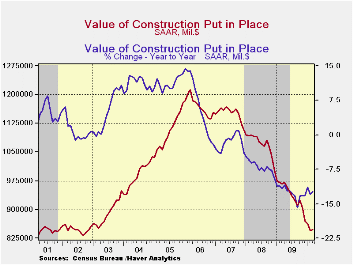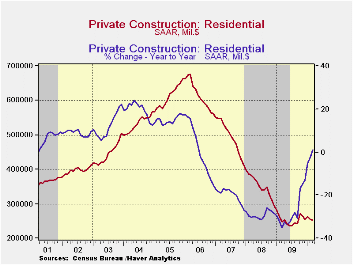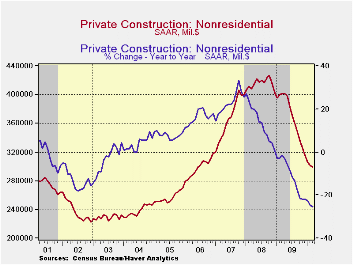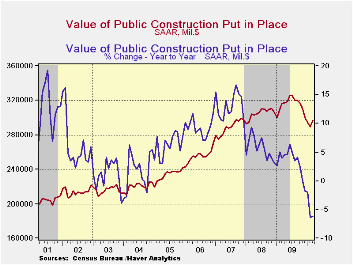 Global| May 03 2010
Global| May 03 2010U.S. Construction Activity Remains Near 2003 Low
by:Tom Moeller
|in:Economy in Brief
Summary
Construction activity remains depressed. The negligible 0.2% uptick in March after the 2.1% February collapse left it near the lowest level since 2003. The latest rise barely beat Consensus expectations for a 0.3% dip. Total private [...]


Construction activity remains depressed. The negligible 0.2% uptick in March after the 2.1% February collapse left it near the lowest level since 2003. The latest rise barely beat Consensus expectations for a 0.3% dip.
Total private construction activity continued lower in March, led down by a 1.1% drop in residential building activity. The decline reflected a 6.3% drop (-58.1% y/y) in multi-family building activity and a 3.0% decline (+6.8% y/y) in improvements. Conversely, single-family construction activity rose 1.6% (17.2% y/y). It has risen consecutively m/m since last June.
Nonresidential building activity fell another 0.7% during March and was off by one-quarter during the last twelve months. Spending on lodging fell by nearly two-thirds during the last year while office construction dropped 42%. Retail shopping centers also have developed a hard downward trend (-39.8% y/y) in addition to school construction (-12.6% y/y). Health care construction also has suffered (-16.3% y/y).
In the public sector, building activity bucked the negative trend and rose 2.3% in March. The gain was led by a 23.7% rise (-14.9% y/y) in power-plant construction. Spending on health-care facilities added to the gain with a 4.9% increase (0.0% y/y) while spending on highways & streets rose 1.5% (-1.4% y/y). Building in the education sector fell 2.2% for the month and was down 16.9% y/y.
The construction put-in-place figures are available in Haver's USECON database.


| Construction Put In Place (%) | March | February | January | Y/Y | 2009 | 2008 | 2007 |
|---|---|---|---|---|---|---|---|
| Total | 0.2 | -2.1 | -0.7 | -12.3 | -12.5 | -6.9 | -1.6 |
| Private | -0.9 | -2.4 | -0.1 | -15.3 | -18.8 | -11.1 | -5.7 |
| Residential | -1.1 | -3.4 | 3.8 | 1.2 | -28.0 | -29.1 | -19.7 |
| Nonresidential | -0.7 | -1.5 | -3.3 | -25.5 | -11.1 | 13.2 | 23.1 |
| Public | 2.3 | -1.6 | -1.9 | -6.3 | 3.3 | 5.6 | 13.1 |
Tom Moeller
AuthorMore in Author Profile »Prior to joining Haver Analytics in 2000, Mr. Moeller worked as the Economist at Chancellor Capital Management from 1985 to 1999. There, he developed comprehensive economic forecasts and interpreted economic data for equity and fixed income portfolio managers. Also at Chancellor, Mr. Moeller worked as an equity analyst and was responsible for researching and rating companies in the economically sensitive automobile and housing industries for investment in Chancellor’s equity portfolio. Prior to joining Chancellor, Mr. Moeller was an Economist at Citibank from 1979 to 1984. He also analyzed pricing behavior in the metals industry for the Council on Wage and Price Stability in Washington, D.C. In 1999, Mr. Moeller received the award for most accurate forecast from the Forecasters' Club of New York. From 1990 to 1992 he was President of the New York Association for Business Economists. Mr. Moeller earned an M.B.A. in Finance from Fordham University, where he graduated in 1987. He holds a Bachelor of Arts in Economics from George Washington University.






